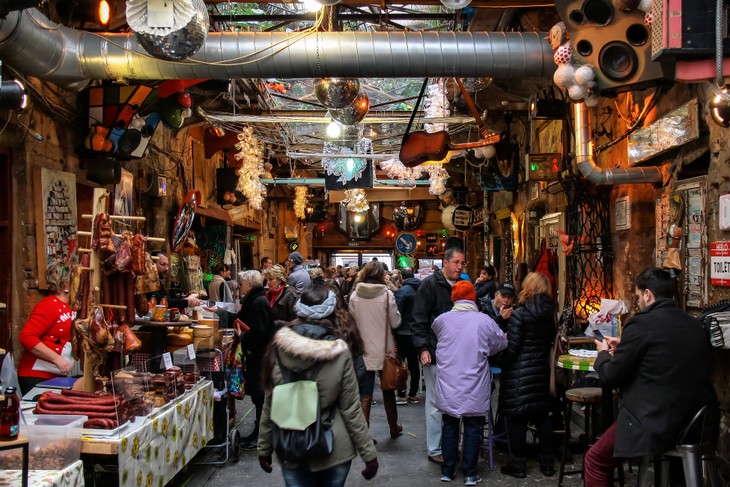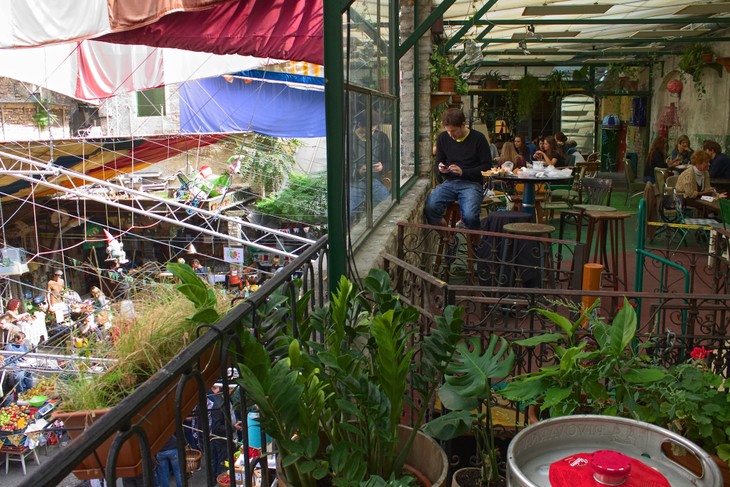(VOVWORLD) - Budapest, the capital of Hungary, seamlessly combines its past and present, exemplified by Buda and Pest, the two distinctive halves of the city separated by the Danube River. While Buda offers a tranquil and somewhat stately atmosphere due to green spaces and ancient attractions, its sibling Pest has rapidly become a tourist favorite as the home to buzzing restaurants, cafes, and an endless stream of unique bars and pubs. If you ever wander Pest streets at night and see long queues of well-dressed young people in front of a run-down, dimly-lit building, chances are you may have stumbled upon a ruin pub.
 Szimpla Kert is a ruin pub you should not miss in Budapest. (Photo: Wikimedia Commons) Szimpla Kert is a ruin pub you should not miss in Budapest. (Photo: Wikimedia Commons) |
Despite being an inseparable part of the current nightlife in this historic city, ruin pubs have only been around for 15 years.
Decades ago, when World War II and the Cold War left Budapest with many abandoned buildings, some young entrepreneurs decided to breathe new life into these dilapidated concrete masses. Thus came the birth of ruin pubs. Initially quaint get-together spots for locals, these pubs quickly gained popularity and became must-visit destinations on tourists’ bucket lists.
“For sure, I will recommend visiting these pubs for first time visitors to Budapest. In fact, that’s exactly what I have been doing for my last 2 years in Budapest. All of my friends really enjoy ruin pubs,” said Nguyen Thuy Linh, a Vietnamese tourism student living in Budapest and a frequent guest of ruin pubs.
Ruin pubs would never have evolved into such a phenomenon today were it not for Szimpla Kert, the very first drinking spot of its kind to exist. Nestled among century-old buildings in the Jewish Quarter, Szimpla might fool its first-time visitors for its modest, somewhat shabby appearance.
Under this disguise, however, is a huge complex of rooms, each with its own unique architecture and a bar that serves affordable beverages. Instead of renovating the building, Szimpla, and other ruin pubs utilized the weathered structure and revitalized it with colorful murals and bizarre artwork. Once incorporated with light and music, it is pure escapism.
“Ruin bars give you a very exciting feeling because of how funky and weird they look. For example, you don’t always see a bar with a bathtub in the middle of a common space, or broken walls with weird posters and signs. It’s just really fun and exciting for me to be in a ruin pub and discover the funny little decorations as I sit down and start enjoying the place,” said Linh.
Unlike Vietnam, whose night-time recreational activities may usually involve enjoying food from a street vendor or relaxing in a coffee shop, it is difficult to find non-alcoholic entertainment when the sun goes down in many European countries, Hungary included. In Budapest, if one wants to meet up with friends after work hours, the most common choice would be to go out for a drink. While a lot of drinking establishments in the city tend to be elegant and exclusive, ruin pubs offer a laid-back, welcoming vibe that appeals to youth.
One can wear their most comfortable, casual outfit and still manage to blend in perfectly with the crowds there. According to Roland Mezo, a Budapest native student, what separates ruin pubs from older-generation ones are their atmosphere and competitive pricing.
“I like the vibe, the decorations, and how it’s not too fancy. It makes you feel more at home because of all the decorations like the radios, the pictures, or some random stuff like a sewing machine,” said Mezo.
 A view from the balcony of a ruin pub in Budapest. (Photo: Wikimedia Commons) A view from the balcony of a ruin pub in Budapest. (Photo: Wikimedia Commons) |
After years of development, many ruin pubs have evolved from their original purpose. Some pubs use their space for art exhibitions and mini concerts.
For instance, Harom Hollo, a ruin pub overlooking the Danube river, utilizes their basement for traditional concerts to popularize indigenous Hungarian folk music to include a wider range of young audiences.
Szimpla Kert also holds a farmers market every Sunday morning – a refreshing break from its endless streams of party-goers by night.
Once a reminder of past political turmoil, several run-down buildings in the city now serve as a testament to Hungarians’ unyielding vitality. Like Budapest, ruin pubs embrace all of their unusual differences. From the ancient hills on the Buda side, crossing over a bridge, tourists will find themselves transported to a different dimension where arts and life converge.